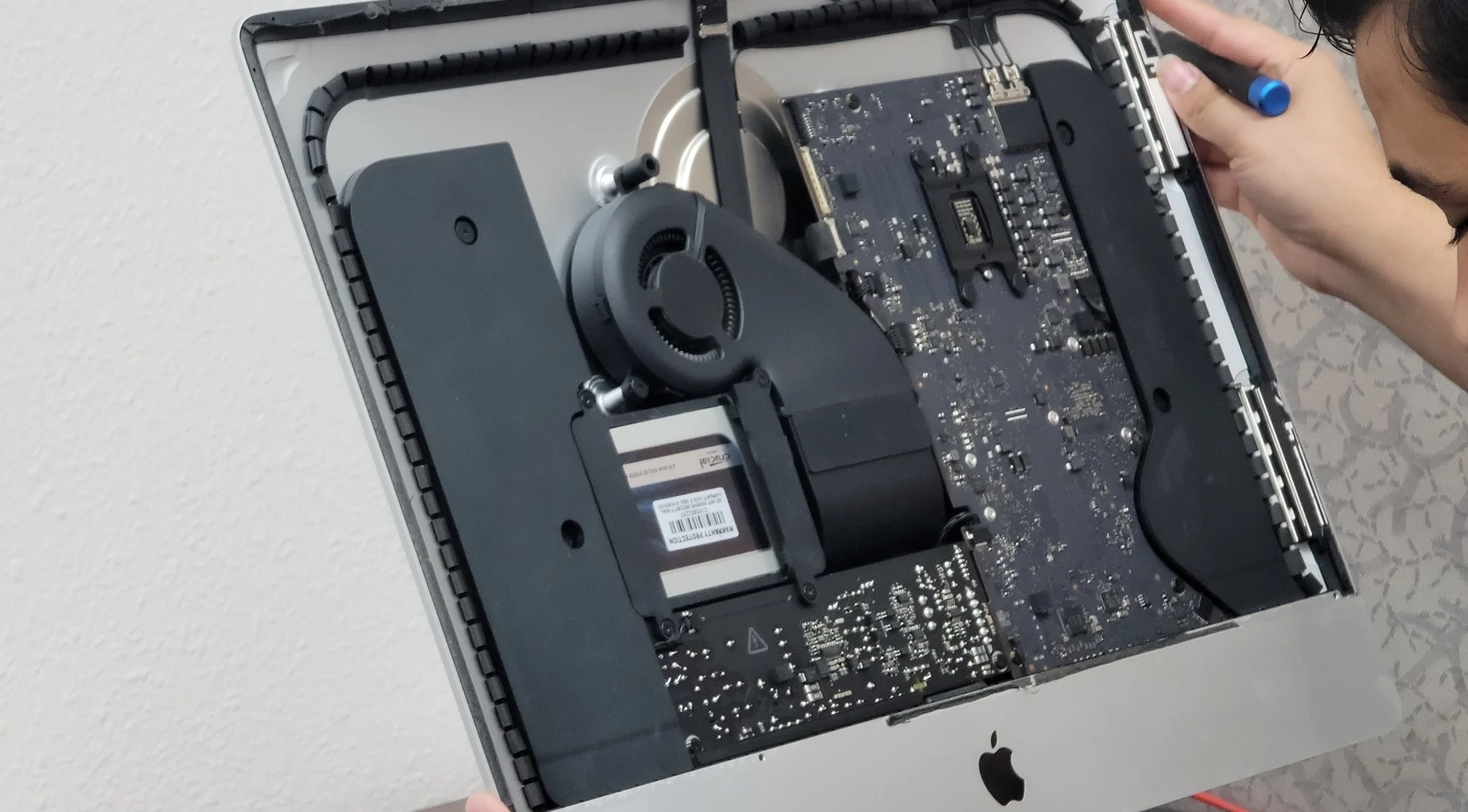The logic board is arguably the most critical component in your MacBook—it's essentially the brain that controls every function of your laptop. When a logic board fails, it can render your entire MacBook inoperable, making it one of the most serious hardware issues you can encounter. Understanding logic board failures, their causes, and warning signs can help you protect your investment and make informed decisions about repairs.
At iCircuit, logic board repairs represent some of the most complex work we perform. Over the years, we've diagnosed and repaired thousands of MacBook logic boards, giving us unique insights into failure patterns, common causes, and effective repair strategies. This comprehensive guide will help you understand everything you need to know about MacBook logic board failures and how to address them effectively.
🧠 What is a MacBook Logic Board?
The Heart of Your MacBook
The logic board is the main circuit board that connects and controls all other components in your MacBook.
Core Components on the Logic Board
The logic board houses the most essential components of your MacBook:
- CPU (Central Processing Unit): The main processor that executes all computing tasks
- RAM slots or soldered memory: System memory for active applications and processes
- GPU (Graphics Processing Unit): Handles all visual processing and display output
- Storage controller: Manages communication with SSD or hard drive
- Power management unit: Controls power distribution throughout the system
- I/O controllers: Manage USB, Thunderbolt, and other external connections
- Audio controller: Processes all sound input and output
- Network controllers: Handle WiFi, Bluetooth, and Ethernet connectivity
Evolution of MacBook Logic Boards
Apple has significantly changed logic board design over the years:
- 2012-2015 MacBooks: Modular design with removable RAM and easier repairs
- 2016-2020 MacBooks: Highly integrated with soldered components and smaller form factors
- M1/M2 MacBooks (2020+): System-on-Chip design with even more integration
- Repair implications: Newer boards are more efficient but much harder to repair
Why Logic Boards are Critical
- Single point of failure that can disable the entire system
- Houses irreplaceable components like the CPU and GPU
- Contains unique identification data tied to your specific MacBook
- Failure often requires professional-level micro-soldering repair
- Most expensive component to replace in your MacBook
⚠️ Critical Warning Signs of Logic Board Failure
Logic board failures rarely happen suddenly—they usually develop gradually with clear warning signs. Recognizing these early symptoms can help you backup data and seek repair before complete failure occurs.
Boot and Power Issues
- No power response: MacBook won't turn on despite charged battery and working charger
- Intermittent power: Randomly shuts down or fails to start
- Stuck on Apple logo: Boot process hangs at startup screen
- Kernel panics: Sudden restarts with "Your computer restarted because of a problem" message
- Power cycling: MacBook turns on for a few seconds then shuts down
Display and Graphics Problems
- No display output: Screen remains black despite system appearing to run
- Distorted graphics: Artifacts, lines, or corrupted images on screen
- GPU glitches: Graphic corruption during video playback or 3D applications
- External display issues: Problems connecting to external monitors
- Backlight problems: Screen extremely dim or flickering brightness
Performance and Stability Issues
- Severe performance degradation: Extremely slow response even for basic tasks
- Application crashes: Frequent app failures, especially system applications
- Memory errors: "Out of memory" errors with plenty of available RAM
- File system corruption: Difficulty accessing files or saving documents
- USB/Thunderbolt failures: Ports stop working or intermittently disconnect
Temperature and Physical Signs
- Excessive heat: MacBook becomes extremely hot during normal use
- Fan behavior: Fans constantly running at maximum speed
- Unusual smells: Burning or electrical odors from the laptop
- Physical damage: Visible damage to ports or obvious impact damage
- Liquid exposure history: Previous spills or liquid contact
🔍 Common Causes of Logic Board Failure
Understanding what causes logic board failures can help you avoid situations that put your MacBook at risk and make informed decisions about repairs and prevention.
Liquid Damage - The #1 Cause
- Immediate damage: Liquid creates short circuits that can instantly destroy components
- Corrosion damage: Even small amounts cause gradual component degradation
- Common liquids: Coffee, water, soda, wine—all are equally damaging
- Hidden damage: Liquid can reach logic board even through keyboard
- Time factor: Damage worsens over time, even after liquid appears dry
- Repair complexity: Requires immediate professional cleaning and component replacement
Overheating and Thermal Damage
- Blocked ventilation: Dust buildup in fans and heat sinks
- Thermal cycling: Repeated heating and cooling causes solder joint failure
- GPU stress: Intensive graphics work generates excessive heat
- Age-related degradation: Thermal paste becomes less effective over time
- Environmental factors: Using MacBook in hot environments accelerates damage
Power-Related Failures
- Power surge damage: Electrical spikes from outlets or lightning
- Charger issues: Using incorrect or damaged chargers
- Battery swelling: Expanding batteries can physically damage logic board
- Power cycling damage: Frequent hard shutdowns stress power circuits
- Voltage regulation failure: Power management chips wear out over time
Manufacturing and Design Issues
- Known design flaws: Some MacBook models have documented logic board issues
- Solder joint failures: Lead-free solder is more prone to cracking
- Component aging: Capacitors and other components degrade over time
- Flexgate issues: Repeated opening/closing damages flex cables
- Quality control: Rare manufacturing defects that appear after warranty
Physical Damage and Abuse
- Drop damage: Impact can crack solder joints or damage components
- Pressure damage: Closing MacBook with objects on keyboard
- Port damage: Forcing cables into ports can damage I/O controllers
- Repair damage: Improper previous repairs causing additional problems
- Age and wear: Normal use over many years gradually degrades components
🔧 Professional Logic Board Repair Process
Logic board repair is one of the most complex procedures in electronics repair, requiring specialized equipment, extensive training, and significant experience. Here's what the professional repair process involves:
Initial Diagnosis and Assessment
- Visual inspection: Checking for obvious damage, corrosion, or burned components
- Power testing: Measuring voltages at key test points on the board
- Component testing: Using multimeters and specialized tools to test individual chips
- Schematic analysis: Referencing detailed circuit diagrams to trace problems
- Liquid damage assessment: Using UV lights and other tools to detect corrosion
- Repair feasibility: Determining if repair is technically and economically viable
Micro-Soldering Repair Techniques
- Component-level repair: Replacing individual chips, capacitors, and resistors
- BGA (Ball Grid Array) work: Specialized technique for CPU and GPU repairs
- Trace repair: Rebuilding damaged circuit paths on the board
- Corrosion cleaning: Removing oxidation and cleaning damaged areas
- Precision soldering: Working with components smaller than a grain of rice
- Quality testing: Extensive testing to ensure reliable repairs
Specialized Equipment Required
- Microscopes: High-magnification stereo microscopes for precision work
- Soldering stations: Temperature-controlled stations with fine tips
- Hot air rework: For removing and installing BGA components
- Ultrasonic cleaners: For removing flux and cleaning components
- Power supplies: Variable DC supplies for testing and diagnosis
- Oscilloscopes: For analyzing complex electrical signals
Repair vs. Replacement Decision Factors
- Extent of damage: Minor component failures vs. major circuit damage
- Age of MacBook: Newer models justify more expensive repairs
- Cost comparison: Repair cost vs. replacement logic board or new MacBook
- Data importance: Sometimes repair is only option to recover data
- Availability of parts: Some older models have limited component availability
- Success probability: Realistic assessment of repair likelihood
Post-Repair Testing and Validation
- Power-on testing: Verifying basic functionality and boot process
- Stress testing: Running intensive applications to test stability
- Thermal testing: Ensuring proper temperature management
- Port functionality: Testing all USB, Thunderbolt, and other connections
- Display testing: Checking internal and external display functionality
- Long-term stability: Extended testing to ensure reliable operation
🛡️ Preventing Logic Board Failures
While some logic board failures are unavoidable, many can be prevented with proper care, maintenance, and usage habits. Prevention is always more cost-effective than repair.
Liquid Protection Strategies
- Workspace setup: Keep drinks away from your MacBook work area
- Spill-proof containers: Use bottles with secure lids instead of open cups
- Keyboard covers: Silicone keyboard protectors can deflect small spills
- Immediate response: If spills occur, power down immediately and seek professional help
- Humidity control: Avoid using MacBook in extremely humid environments
- Storage considerations: Store in dry environments, use desiccant packets if needed
Thermal Management Best Practices
- Regular cleaning: Have fans and heat sinks cleaned professionally every 12-18 months
- Proper ventilation: Use on hard, flat surfaces that don't block air vents
- Cooling pads: Consider laptop cooling pads for intensive work
- Activity monitoring: Use Activity Monitor to identify CPU-intensive processes
- Environment awareness: Avoid direct sunlight and hot environments
- Thermal throttling: Allow MacBook to slow down rather than forcing performance
Power and Electrical Protection
- Genuine chargers only: Always use Apple-certified chargers and cables
- Surge protection: Use quality surge protectors in your workspace
- Battery maintenance: Replace swelling batteries immediately
- Power cycling avoidance: Use proper shutdown procedures instead of force restarts
- Electrical storm precautions: Unplug during severe weather
- UPS systems: Consider uninterruptible power supplies for critical work
Physical Protection and Handling
- Quality cases: Invest in protective carrying cases for transport
- Gentle handling: Open and close lid carefully, don't slam shut
- Screen protection: Never place objects on keyboard before closing
- Port care: Insert cables gently and remove when not needed
- Transport precautions: Remove external devices before moving MacBook
- Professional servicing: Have issues addressed by qualified technicians
Monitoring and Maintenance Schedule
- Temperature monitoring: Use apps like TG Pro to watch system temperatures
- Battery health checks: Monitor battery condition in System Information
- Performance baselines: Notice changes in typical performance patterns
- Error log review: Check Console app for unusual error messages
- Regular backups: Maintain current backups in case of sudden failure
- Professional check-ups: Annual professional cleaning and inspection
Logic board failures represent the most serious hardware issue your MacBook can experience, but understanding the warning signs and causes empowers you to take preventive action and make informed repair decisions when problems arise.
Remember that logic board repair requires specialized expertise and equipment that's beyond the scope of typical computer repair shops. If you suspect logic board issues, it's crucial to work with technicians who have specific training in micro-soldering and MacBook logic board repair. Early intervention can often save your MacBook and your data, while delayed action may result in complete data loss and irreparable damage.
Logic Board Issues? We Can Help
Our certified micro-soldering specialists can diagnose and repair even the most complex logic board failures. Professional repair with data recovery and warranty protection.
Board-level repair specialists with 90-day warranty
Logic Board Specialist
Certified technician with 10+ years experience in MacBook logic board repairs
Published: June 15, 2025



